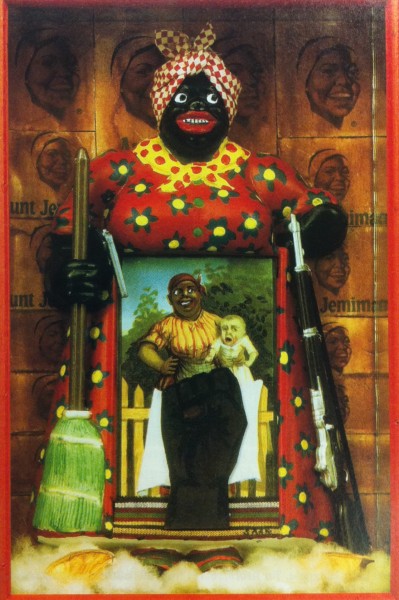 Betye Saar, The Liberation of Aunt Jemima, 1972, Mixed media, 20.3 X 29.8 X 6.9 cm, University Art Museum, University of California, Berkley. Photo by Erika Clugston, Creative Commons Attribution-ShareAlike 2.0 Generic License.
Betye Saar, The Liberation of Aunt Jemima, 1972, Mixed media, 20.3 X 29.8 X 6.9 cm, University Art Museum, University of California, Berkley. Photo by Erika Clugston, Creative Commons Attribution-ShareAlike 2.0 Generic License.
The Art Minute University: Erika Clugston, a student at Southwestern University in Georgetown, TX, wrote this post.
Betye Saar’s found object assemblage, The Liberation of Aunt Jemima (1972), re-appropriates derogatory imagery as a means of protest and symbol of empowerment for black women.
Emerging from a historical context fraught with racism and sexism, Saar’s pivotal piece works in tandem with the civil rights and feminist movements. The cotton balls at the feet of the Jemima figure, the broom, and the image of the woman with the white child each speak to specific roles into which African American women were historically allocated. Saar takes these painful memories and alters them, arming the stereotypically docile mammy figure with a gun and hand grenade and giving agency to the traumatized icons of the past.
Aunt Jemima has been armed and empowered with a new identity.
She’s done making pancakes.
 Betye Saar, The Liberation of Aunt Jemima, 1972, Mixed media, 20.3 X 29.8 X 6.9 cm, University Art Museum, University of California, Berkley. Photo by Erika Clugston, Creative Commons Attribution-ShareAlike 2.0 Generic License.
Betye Saar, The Liberation of Aunt Jemima, 1972, Mixed media, 20.3 X 29.8 X 6.9 cm, University Art Museum, University of California, Berkley. Photo by Erika Clugston, Creative Commons Attribution-ShareAlike 2.0 Generic License.
 Betye Saar, The Liberation of Aunt Jemima, 1972, Mixed media, 20.3 X 29.8 X 6.9 cm, University Art Museum, University of California, Berkley. Photo by Erika Clugston, Creative Commons Attribution-ShareAlike 2.0 Generic License.
Betye Saar, The Liberation of Aunt Jemima, 1972, Mixed media, 20.3 X 29.8 X 6.9 cm, University Art Museum, University of California, Berkley. Photo by Erika Clugston, Creative Commons Attribution-ShareAlike 2.0 Generic License.

